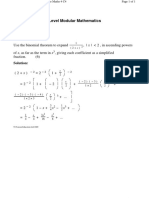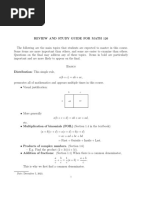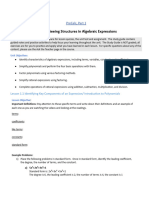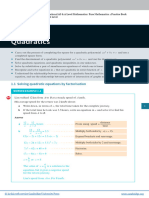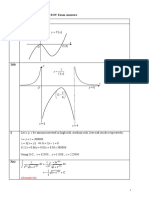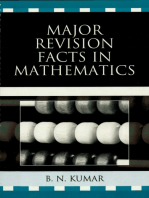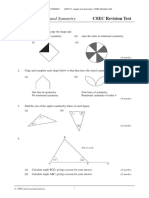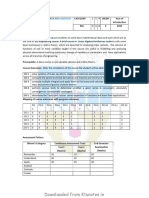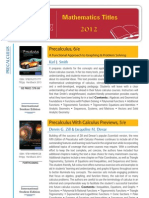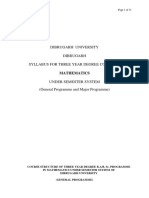UNIT 23 Algebraic Manipulation Introduction To SIM: Learning Objectives
Uploaded by
Charlotte BUNIT 23 Algebraic Manipulation Introduction To SIM: Learning Objectives
Uploaded by
Charlotte BMEP Jamaica: STRAND G UNIT 23 Algebraic Manipulation: Introduction to SIM
UNIT 23 Algebraic Manipulation Introduction to SIM
Learning objectives
This unit continues the algebraic concepts theme of the previous two units. After completing this unit
of STUDENT INSTRUCTIONAL MATERIAL (SIM) you should be able to
• solve simultaneous equations
• fully expand brackets
• factorise expressions by taking out single terms and linear terms
• factorise quadratic expressions into two linear terms.
Key points and principles
• Simultaneous linear equations are of the form
ax + by = c
dx + ey = f
when a, b, c, d, e and f are constants.
• Simultaneous linear equations normally have unique solutions, but not when one equation is the
multiple of another. For example, when
x + y =1
2x + 2y = 2
there is no unique solution. Also when there are two inconsistent equations, for example,
x + y =1
x+y=3
there are NO solutions.
• Having obtained solutions for x and y for simultaneous linear equations, you should then always
check this solution for x and y in the original equations.
• When expanding brackets, ensure that all terms are considered. For example,
2 x ( x + 3) = 2 x × x + 2 x × 3
= 2x2 + 6x
• When taking out simple factors from an equation, ensure that you take out all possible factors.
For example, 2x2 + 6x (
= 2 x 2 + 3x ) (taking out the constant term 2)
= 2 x ( x + 3) (taking out the factor x)
• For quadratic factorisation of x 2 + ax + b , if factors of the form ( x + c) ( x − d ) exist, then
a = c + d , b = cd
© CIMT and e-Learning Jamaica 1
MEP Jamaica: STRAND G UNIT 23 Algebraic Manipulation: Introduction to SIM
UNIT 23 Algebraic Manipulation Introduction to SIM
Facts to remember
• (a + b) (a − b) = a2 − b2
• ( a + b )2 = a 2 + 2 ab + b 2
• ( a − b )2 = a 2 − 2 ab + b 2
• If x 2 + ab + b = ( x + c) ( x + d ) , then
a = c + b and b = cd
Glossary of Terms
Simultaneous linear equations These are of the form
ax + by = c
dx + ey = f
when a, b, c, d, e and f are constants.
Expanding brackets Expressions such as a ( x + b) are expanded out.
For example,
2 ( x + 3) = 2 x + 6
x (4 − x ) = 4 x − x 2
2 x (1 + 3 x ) = 2 x + 6 x 2
a ( x + b) = ax + ab
Linear factorisation Single factors are taken out of an expression.
For example,
3 x + 9 = 3 ( x + 3)
4 x 2 + x = x ( 4 x + 1)
5 x 2 + 10 x = 5 x ( x + 2)
Quadratic factorisation Quadratic expressions are factorised into linear factors.
For example,
x 2 + 5 x + 6 = ( x + 3) ( x + 2)
x 2 − 4 = ( x + 2) ( x − 2)
(2 x − 1) ( x + 2) = 2 x 2 + 3x − 2
© CIMT and e-Learning Jamaica 2
You might also like
- Topical Revision Notes Additional Mathematics O Level PDF100% (9)Topical Revision Notes Additional Mathematics O Level PDF186 pages
- Linear Algebra Coursebook 2021-2022 - University of Twente - Lecture NotesNo ratings yetLinear Algebra Coursebook 2021-2022 - University of Twente - Lecture Notes154 pages
- ALGEBRA Unit 1 Algebraic Manipulation IntroductionNo ratings yetALGEBRA Unit 1 Algebraic Manipulation Introduction3 pages
- Integration of Rational Fractions: 4.1 Integration For None Repeated Linear FactorsNo ratings yetIntegration of Rational Fractions: 4.1 Integration For None Repeated Linear Factors6 pages
- 2023 MAV MathsMethods Trial Exam 1 SolutionsNo ratings yet2023 MAV MathsMethods Trial Exam 1 Solutions10 pages
- Solutionbank: Edexcel AS and A Level Modular MathematicsNo ratings yetSolutionbank: Edexcel AS and A Level Modular Mathematics12 pages
- 0a.review of Pre-Requisite Skills - Ja21 (Answers)No ratings yet0a.review of Pre-Requisite Skills - Ja21 (Answers)5 pages
- Bridging Unit: Algebra 1: Topic C: Factorising Quadratics and Simple CubicsNo ratings yetBridging Unit: Algebra 1: Topic C: Factorising Quadratics and Simple Cubics19 pages
- 122 Class Test (E-TMAS) Student Copy (2)No ratings yet122 Class Test (E-TMAS) Student Copy (2)4 pages
- Preparatory Questions: Solutions To Tutorial 5No ratings yetPreparatory Questions: Solutions To Tutorial 58 pages
- Politecnico Di Torino: Bridging Course in Mathematics Sheet 1 PolynomialsNo ratings yetPolitecnico Di Torino: Bridging Course in Mathematics Sheet 1 Polynomials10 pages
- Order of Operations Pemdas: Commutative LawNo ratings yetOrder of Operations Pemdas: Commutative Law4 pages
- Factoring and Algebra - A Selection of Classic Mathematical Articles Containing Examples and Exercises on the Subject of Algebra (Mathematics Series)From EverandFactoring and Algebra - A Selection of Classic Mathematical Articles Containing Examples and Exercises on the Subject of Algebra (Mathematics Series)No ratings yet
- UNIT 31 Angles and Symmetry: CSEC Multiple Choice QuestionsNo ratings yetUNIT 31 Angles and Symmetry: CSEC Multiple Choice Questions3 pages
- UNIT 31 Angles and Symmetry CSEC Revision TestNo ratings yetUNIT 31 Angles and Symmetry CSEC Revision Test4 pages
- UNIT 23 Algebraic Manipulation CSEC Revision Test: X X y X XNo ratings yetUNIT 23 Algebraic Manipulation CSEC Revision Test: X X y X X3 pages
- 23 Algebraic Manipulation: Student TextNo ratings yet23 Algebraic Manipulation: Student Text17 pages
- Student Text Answers: UNIT 23 Algebraic ManipulationNo ratings yetStudent Text Answers: UNIT 23 Algebraic Manipulation4 pages
- The University of The West Indies: FEBRUARY, 2013No ratings yetThe University of The West Indies: FEBRUARY, 201310 pages
- Class10 Math Pairoflinearequationsintwovariables Questionbank 59280100% (1)Class10 Math Pairoflinearequationsintwovariables Questionbank 5928039 pages
- Partial Differential Equations: Analytical and Numerical MethodsNo ratings yetPartial Differential Equations: Analytical and Numerical Methods136 pages
- Introduction To Programming in MATLAB: Lecture 3: Solving Equations and Curve FittingNo ratings yetIntroduction To Programming in MATLAB: Lecture 3: Solving Equations and Curve Fitting39 pages
- ME 17 - Homework #5 Solving Partial Differential Equations Poisson's EquationNo ratings yetME 17 - Homework #5 Solving Partial Differential Equations Poisson's Equation10 pages
- Applied Mathematics-I (MATH114) : Lecture1: Introduction and Basic of MatricesNo ratings yetApplied Mathematics-I (MATH114) : Lecture1: Introduction and Basic of Matrices15 pages
- M.sc. Maths & Computing Syllabus AR 2018No ratings yetM.sc. Maths & Computing Syllabus AR 201857 pages
- Module Lesson 1.6 Systems of Nonlinear Equations100% (1)Module Lesson 1.6 Systems of Nonlinear Equations6 pages
- Numerical Methods For The Simulation of Chemical Engineering ProcessesNo ratings yetNumerical Methods For The Simulation of Chemical Engineering Processes14 pages














